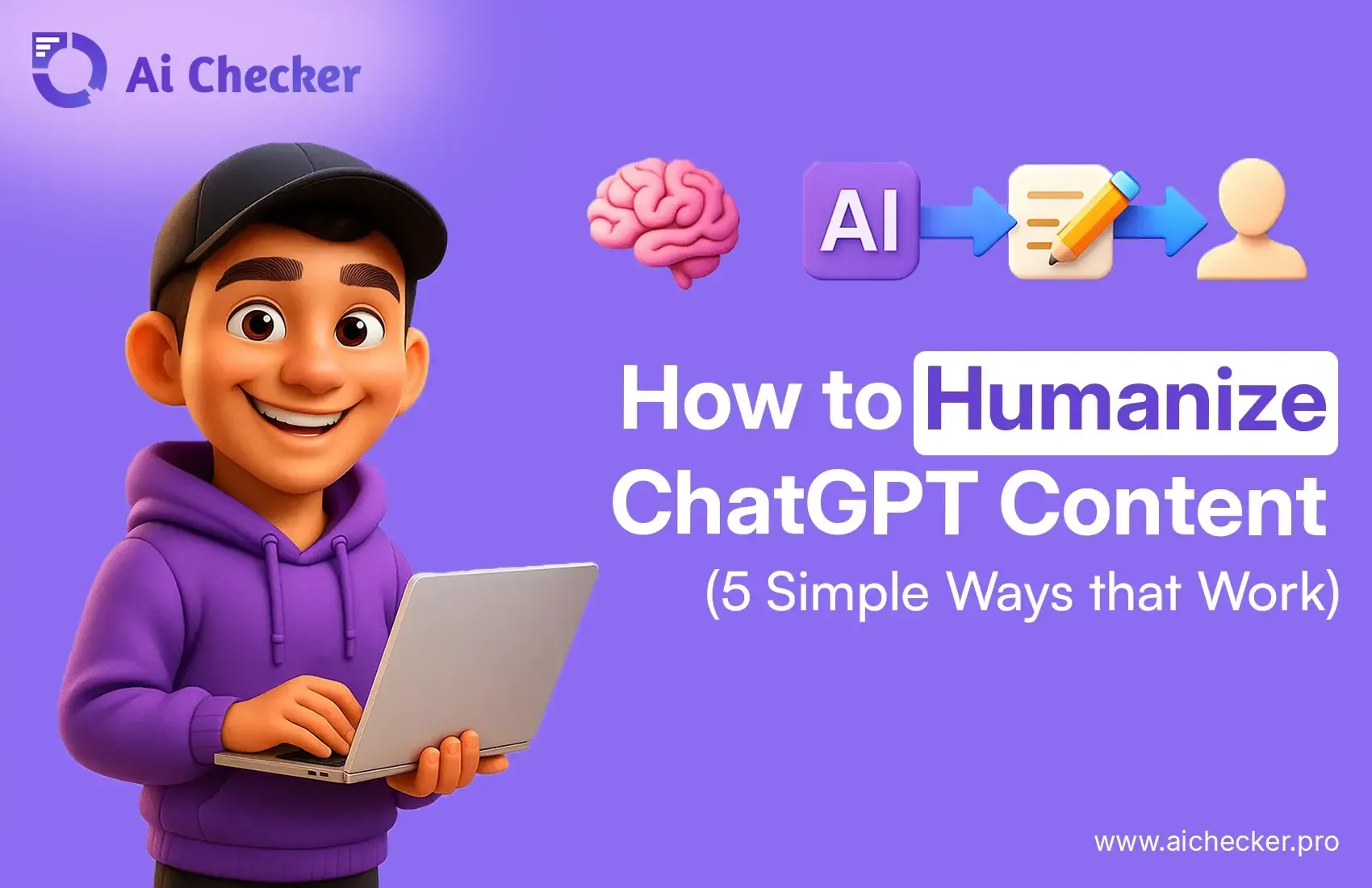Sign In
Welcome to AI Checker Sign in to continue your exploration of our platform with all its exciting features.
Forgot Password?
Don’t have an account ? Sign Up
Forgot Password
We'll Send You An Email To Reset Your Password.
Back to Login
Sign Up
Embrace the Future with AI Checker Sign up now and let's rewrite the possibilities together.
Already have an account? Sign In
Enter OTP
We'll send you an email to reset your password.
Back to Login
Enter OTP
We'll send you an OTP on your registered email address.
Back to Login
Confirm Password
Please enter your new password.
How to Humanize ChatGPT Content (5 Simple Ways that Work)
 Megan Haris
Megan Haris
TABLE OF CONTENTS
The Problem with Raw ChatGPT
Way #1: Tweak Your ChatGPT Prompts for Human-Like Output
Way #2: Vary Sentence Structure and Length
Way #3: Remove Buzzwords and Add Personal Touches
Way #4: Edit for Conversational Flow and Natural Language
Way #5: Analyze Your Own Writing and Teach ChatGPT Your Style
Common ChatGPT Patterns to Avoid
Step-by-Step Workflow to Humanize Content
Before and After Examples
Conclusion
FAQs
ChatGPT can generate content in seconds. However, the cornerstone output will sound very robotic, very formulaic, and clearly generated by a machine. Google penalizes this. Universities flag it. Your audience ignores it.
The answer? Learn to humanize your ChatGPT-generated content with these 5 techniques. All of these techniques take boring AI-generated output and make it fresh, passionate text readers will connect with.
The Problem with Raw ChatGPT
Raw ChatGPT output has predictable patterns:
- Uses same favorite phrases repeatedly ("Furthermore," "It is worth noting that")
- Uniform sentence length and structure
- Generic, vague examples
- Zero personal voice or personality
- Overly formal tone everywhere
This is why learning to humanize ChatGPT content is essential in 2025.
Way #1: Tweak Your ChatGPT Prompts for Human-Like Output
The most effective method for obtaining more human content boils down to better prompts right from the beginning.
Instead of Generic Requests
Bad prompt: Write a blog post about productivity
Better prompt: Write a blog post about productivity as if you were talking to a friend. Be honest about what you actually think works. Include one personal story about the time you learned this lesson the hard way. Use both short sentences and longer sentences.
Providing specific direction regarding the tone of the writing, the perspective of the writing, and specific examples within your prompt, immediately makes the output feel more human.
Effective Prompt Examples
To be blogs: "Write like you're sharing something you learned yourself. Use specific examples. Change your sentences up. Sound like a friendly expert, not like a textbook."
To be an email: "Write like you're talking to a colleague you like. Be warm but professional. Sound like a real person, not corporate. Use specific characteristics."
To be social media: "Be genuine and honest. Use real language. Use real examples, not general sayings. Sound like a real person."
Way #2: Vary Sentence Structure and Length
ChatGPT produces consistent sentences that are similar in length. However, people mix short and punchy sentences with longer and complex ones in a natural way.
The Power of Mixing
Instead of: " The research was exhaustive. The data was collected in an organized manner. The analysis was comprehensive. The results were important."
You could say: "The research covered all of the bases. We collected data over six months, looking at every detail the entire time. The results? They were significant."
Can you see the rhythm and flow? That is how humanized content feels.
Variation Techniques
- Open paragraphs with brief, impactful sentences.
- Then offer longer details.
- Include rhetorical questions on occasion.
- Use the occasional one-word sentence for emphasis: "Exactly." "Wrong." "Precisely."
- Employ a pattern of statement, question, explanation.
The variation is one of the strongest techniques for humanizing the ChatGPT-generated text.
Way #3: Remove Buzzwords and Add Personal Touches
All AIs have phrases where you can tell it is an AI. It is important to figure out what those are and to replace them.
ChatGPT's Favorite Phrases (Avoid These)
"Furthermore" → "Plus," "Also," or "Beyond that"
"It is worth noting that" → "Here is what matters," or "Notice that"
"Leverage" → "Use," or "Apply"
"Delve into" → "Explore," or "Look at"
"In conclusion" → "So," or "Ultimately," and even just start talking normally
"Subsequently" → "Then," or, "After that"
Add Real Examples and Stories
ChatGPT examples are generic. Your authentic examples trump anything ChatGPT provides.
Instead of: "It is important to be consistent in working on goals."
Try: "I learned to embrace consistency the hard way. For two years I would work on projects for a week, and then not touch them for three weeks. Two years of this same routine passed and I finally committed to simply 'showing up' every day. Sometimes that meant showing up for 30 minutes. This cycle would eventually change everything for me. I began to focus on real progress."
Your story, your way, is what makes content memorable and human.
Way #4: Edit for Conversational Flow and Natural Language
ChatGPT's text sounds like someone's reading a robot's script. Real conversation flows like a conversation.
Use Contractions Naturally
ChatGPT doesn't use colloquialisms. Real people do.
Think of as an example "It is" v. "It's."
Or "Do not" v. "Don't."
Or "Cannot" v. "Can't."
Or "We are," v. "We're."
Use "We'd" instead of "We would" or "We are going to" to sound even more human.
Strategically adding a few choice contractions makes the content sound instantly more human.
Add Emotion and Personality
Instead of, "The situation got complicated in ways we did not anticipate."
Try, "Everything went sideways. Honestly, it was chaos. But honestly, the chaos taught us a lot more than any smooth project we've ever worked on."
Give emotion and use humor where appropriate.
Use Natural Transitions
ChatGPT transitions: "Furthermore," "Moreover," "In conclusion"
Real transitions: "Here's the thing," "But that's not the whole story," "So what does this mean," "Here's where it gets interesting"
Way #5: Analyze Your Own Writing and Teach ChatGPT Your Style
The most optimal method is to instruct ChatGPT to write like you.
Provide Your Writing Samples
Keep your preferred emails, blog posts, social content. Provide these to ChatGPT:
"Here are examples of my writing style: [examples]. Write something in this style about [topic]."
Use Custom Instructions
In ChatGPT settings, add: "Write in my voice. Be conversational and use contractions. Don't use corporate speak. Make it sound like it's advice from a mentor, not a textbook."
These apply to every conversation, and significantly improve ChatGPT's output for you.
Give Feedback
When ChatGPT gets it right, tell it what it got right. When it misses, tell it why it missed. ChatGPT learns from feedback and adapts to your preferences.
Common ChatGPT Patterns to Avoid
Overused Opening Phrases
❌ "In today's digital world..."
❌ "In this modern era..."
❌ "It is important to note that..."
✅ "I made a huge mistake," "Here's what I got wrong," "Let me tell you what actually works"
Repetitive Structures
When there is repetition of the same structure for many sentences (all starting with "The [noun]..."), it is an indicator that the content was generated by AI. Vary the starts to your sentences.
Generic Examples
"Many people" → Get specific numbers instead.
"Improve your life" → "Helped me earn an extra $2,000/month"
"Various studies show" → "The 2023 Stanford study found"
The more specific you are, the more you break the AI-generated content pattern.
Step-by-Step Workflow to Humanize Content
Step 1: Generate Ask ChatGPT for the first draft using detailed prompts. Read through without editing.
Step 2: Identify Robotic Sections Mark paragraphs that:
- Use obvious buzzwords
- Have uniform sentence length
- Include generic examples
- Lack personal voice
Step 3: Manual Rewriting
- Rewrite marked sections in your own voice
- Add personal examples
- Vary sentence structure
- Replace AI phrases with natural language
Step 4: Test
- Run through AI detector (GPTZero, Originality AI)
- Ask: "Does this sound like me?"
- Check for remaining AI patterns
Step 5: Polish
- Verify facts and sources
- Check consistency
- Final read-through
Before and After Examples
Example 1: Blog Post
ChatGPT: "Establishing sound time management methods is paramount for success in your profession. In addition, an organizational system provides the opportunity for greater productivity."
Humanized: "I used to be really bad at managing my time. I would start well, and then get overwhelmed with all the items that needed my attention—my inbox would swell, and deadlines would get closer. What I did realize is that I was not bad at managing my time—I was bad at saying no. When I began to really defend my time, everything changed."
Example 2: Email
ChatGPT: "Dear Recipient, I hope this letter reaches you in good spirits. Given the recent development and all that has transpired since our last meeting, I think it would be timely to plan a more thorough meeting in order to develop a plan to put our plans into action."
Humanized: "Hi [Name], I wanted to catch up with you on the project. We have had a few changes and I want to make sure we're on the same page. Do you have about 30 minutes next week for us to connect?"
Example 3: Social Media
ChatGPT: "Being consistent is the most important thing to achieving professional ambitions. Persisting is the most important thing to success."
Humanized: "Consistency beats perfection every time. You don't have to be brilliant today. Just show up tomorrow when you are supposed to. Show up the next day too. That's how real progress is made.”
Conclusion
These 5 ways to humanize ChatGPT content really work:
- Better prompts = Better initial output
- Varied sentences = Natural rhythm
- Remove buzzwords = No AI red flags
- Conversational tone = Real engagement
- Your style = Authentic voice
The process is simple:
- Generate with ChatGPT
- Identify robotic sections
- Rewrite in your voice
- Add personal examples
- Test and polish
Start with one piece of content. Apply just one or two techniques. See the difference. Build from there.
Within a few weeks of practice, you'll have a system that works automatically. ChatGPT becomes your writing partner, not your replacement. Your authentic voice shines through. Your content engages readers. Your rankings improve.
That's the power of learning to humanize ChatGPT content properly.
FAQs
1. Will humanized content pass AI detectors?
Yes, when done properly with personal insights, varied structure, and specific examples. But the real goal is creating genuinely good content.
2. How long does humanization take?
Plan on 30-60% of your writing time for editing. It gets faster with practice.
3. Can I use automated tools instead of manual editing?
Tools can help, but manual editing creates better results. Use tools as a starting point, not a solution.
4. Do I always need personal stories?
Personal stories work best for blogs and social media. Technical content needs personality, but not always stories.
5. How do I know my writing voice?
Look at your best writing. What makes it different? What tone do you naturally use? Start there.
6. Can I use these techniques for all writing types?
Yes, blogs, emails, social posts, technical docs, sales copy. These principles work everywhere.

Megan Haris
Content writer at @Aichecker
I am a content writer at AI Checker Pro, where I craft engaging, SEO-optimized content to enhance brand visibility and educate users about our AI-driven solutions. My role involves creating clear, impactful messaging across digital platforms to drive engagement and support company growth.

